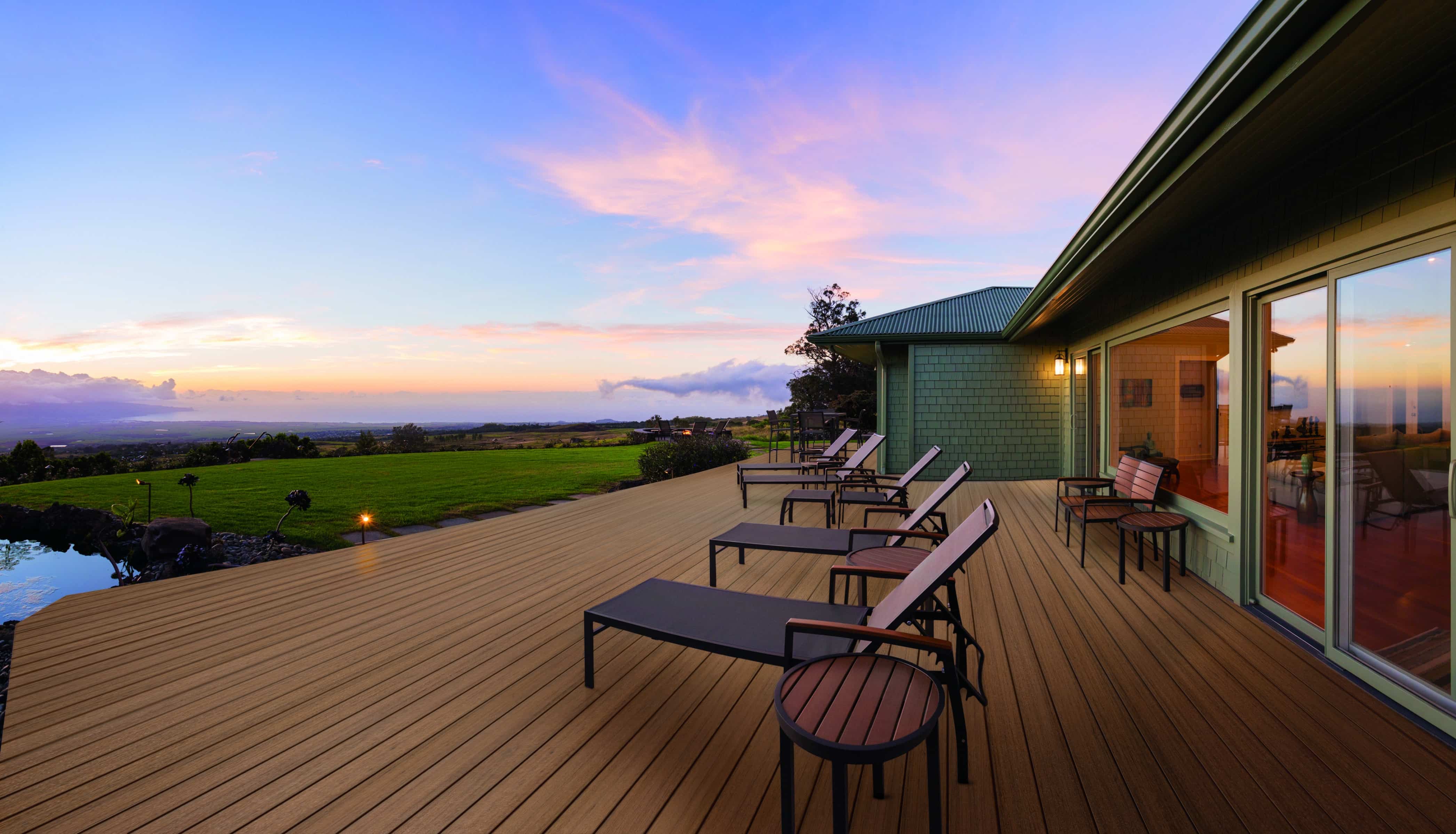
Wood or Composite Decking: Which is Best?
Few homeowners think of it this way, but adding a comfortable deck increases their square footage without the massive expense of an addition. As with any home improvement, the key is finding the right option.
Let’s look at two core decking options for your outdoor oasis: natural wood vs. composite decking. What’s the difference? How do your choices affect costs? What are the advantages and disadvantages of each?
Check out this comprehensive guide from the experts at Decks & Docks to help you decide what materials are best for your deck or marina project!
Wood vs. Composite Decking: The Basics
Before discussing the differences between wood and composite boards, it’s helpful to define each.
- Wood decking refers to boards taken straight from the tree and contain no artificial materials. The most popular woods for decking include pressure-treated lumber and exotic hardwoods. Even if it’s treated, wood is organic and will eventually decay.
- Composite decking may be PVC, high-density polyethylene (HDPE), or a proprietary combination of recycled materials.
As your one-stop shop for marine construction materials, Decks & Docks carries both wood and premium composite deck materials at our locations across the East Coast.
Advantages of Real Wood
There are plenty of reasons people choose real wood for their decks. Many homeowners enjoy using natural materials rather than synthetic ones. There are other benefits to natural wood as well:
- Natural products tend to be cheaper than composite wood, although hardwood can be comparatively expensive.
- Ability to choose from a variety ofwood types, from pine to mahogany, that vary in appearance, cost, and quality.
- Wide selection of colors, including the wood’s natural color or a more tinted stain.
Disadvantages of Real Wood
Traditional wood requires more maintenance than composite, so it takes more time and money over the years. Other things to consider:
- More work for the homeowner, with sealing and staining every 2-3 years and stripping and sanding every six years. (General rule of thumb: the less your wood costs, the more maintenance it requires.)
- Natural wood is also more likely to chip, splinter, warp, and rot. You also need to clean it the right way. For instance, you will likely have to power wash it on a much lower setting to remove heavy dirt and mold.
Composite Deck Boards
Hollow and solid composite boards have their own pros and cons, but for the sake of simplicity, let’s look at an overview.
Advantages of Composite Deck BoardsThere are plenty of great reasons to consider composite wood for your deck:
- Gentler on the environment. While real wood requires chopping down trees, composite deck boards can be made from recycled materials. Not all composites are recycled, though, so look for this feature if that’s a priority for you.
- Lack of maintenance. Unlike natural wood, you won’t need to strip, sand, seal, or stain it. Once installed, it can last a long time with little maintenance other than regular cleaning.
- Easier to clean than real wood. Pressure washing is a fast way to get rid of mildew, pollen, and other stubborn grime. For milder issues, you can wash it with a basic brush and detergent. Steer clear of bleach, though.
- Ability to shop by feature. For instance, if your deck is in a high-sun area, look for a sun-resistant coating. Because composite is man-made, the manufacturer has more control over each item’s features.
Disadvantages of Composite Deck Boards
The most significant hurdle of composite decking is the upfront cost because composite materials cost more than natural wood. However, keep in mind that over the life of a deck, the costs between real wood and composite decking tend to even out, and you can come out ahead with composite materials. This is due to the larger ongoing maintenance cost that real wood requires.
Some challenges of composite decking materials are:
- Flexibility. If the color fades, you may not be able to refresh it. With real wood, it’s easy to re-stain it when the color fades. In most cases, though, composite wood isn’t compatible with paint.
- Fewer options on the aesthetic side, as composing decking often comes in a set group of colors. Unlike real wood, you can’t simply change the color by picking from a large selection of stains.
A Cost Comparison for Wood Vs. Composite Decking
Choosing the right materials for your deck or marina is about more than just today’s budget. It’s also about how your deck stands up over time and to the elements.
Costs for Real Wood Decking
Natural wood has an undeniable authenticity that some homeowners love. How does it match up when it comes to finances? Here’s what you need to know.
Initial Installation
While not all wood is equal when it comes to being suited for decking, one of the most common reasons homeowners choose real wood is its low initial price. If you’re dealing with a budget shortage in the short term but don’t want to wait, a real wood deck might be the choice for you.
A large part of the price difference, though, comes from how durable different wood is. Some varieties of pressure-treated wood will last longer against extreme weather, so they may be worth the extra cost.
Maintenance
As enticing as the initial cost is, real wood does cost a pretty penny to maintain. In most cases, you’ll need to sand and re-stain your deck at least every two years, but many homeowners find themselves doing this every year.
Replacements
Part of using a natural material is accepting that it will break down over time. When it comes to real wood, you can expect to replace your deck every 15-20 years (and that’s if you’re maintaining it well). That number can go up or down depending on your local climate, the wood you choose, and more. For example, ipe hardwood has been known to last between 40 and 75 years outdoors!
Additionally, pests destroy wood fibers and bore holes into natural lumber, compromising a deck’s integrity over time. Marine pests typically target wood species and lumber close to water, while carpenter bees can nest in wood decks far inland.
Costs for Composite Deck Material
How does composite deck material hold up compared to wood? The allure of choosing composites comes from the enticing prospect of reduced lifetime expenses. Sure, composite deck materials have a higher initial investment, but consider the following factors that add to future savings.
Initial Installation
Composite decking tends to be more expensive than natural wood decking materials in terms of initial cost. However, many factors contribute to offsetting this cost—read on for more info.
Maintenance
Composite decking is known for its low-maintenance life. In fact, for many people who choose composite decking vs. wood, maintenance is their deciding factor. There’s no need to sand or refinish a composite deck. The only maintenance you can expect is a thorough cleaning every three or four years. Compared to annual or bi-annual refinishing, these cleanings are far less expensive and time-consuming.
Replacements
You’ll be happy to know that you can expect more time out of your composite deck boards than from real wood because it doesn’t break down like natural wood and resists environmental damage and pests.
There’s no hard and fast estimate for how long your composite deck will last. Many composite brands come with at least a 25-year manufacturer’s warranty. The artificial materials in composite deck boards (such as recycled plastic) take longer to break down than the organic fibers in wood and are less susceptible to environmental damage.
Bottom Line on Cost Analysis
While the upfront material costs with natural lumber tend to be lower, there are more ongoing costs associated with natural lumber vs. composite. Depending on how long you plan to own your home or manage your marina, composite may involve fewer costs in the long run because it requires less maintenance.
Aesthetics: Which Looks Better?
Older generations of composite were known for having somewhat of a “flat” look without the natural color variations and patterns of lumber. However, composite technology has evolved in recent years—and now brands like Trex and TimberTech carry color options that better mimic the beauty of natural lumber.
Still, striking exotic hardwoods like ipe and tigerwood have no artificial competitors. If you’re looking for rich, deep color and bold wood grains, natural timber is the way to go.
Need Help Choosing Between Wood and Composite Decking?
Consider your lifestyle, budget, aesthetic taste, and ability to maintain your decking. Wood decks have all the charm of natural beauty but struggle against moisture, sun, and temperature changes. Composite decks, however, stand tough against all weather conditions, offering greater longevity and lower maintenance.
With so many options on the market, it can take time to pick the most suitable material for your next deck. If you still need help comparing your options and selecting something that fits your budget and style, we’re here to help.
Contact the Decks & Docks team, or swing by one of our stores to speak with an expert. We’re always happy to help however we can.
- About the Author
- Latest Posts
Dan has worked for Decks and Docks for over twenty-five years. He managed the original Decks and Docks store in St. Pete, which is our largest store. Dan is simply the best all around. He knows more about this company and our products than probably anyone else. Dan currently works in Sales at our corporate office.
